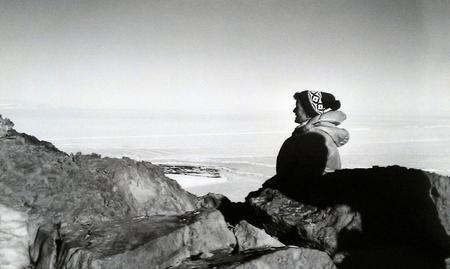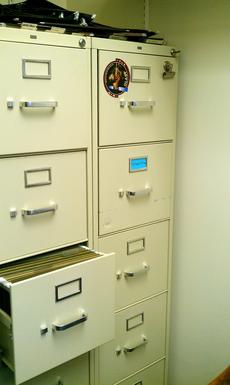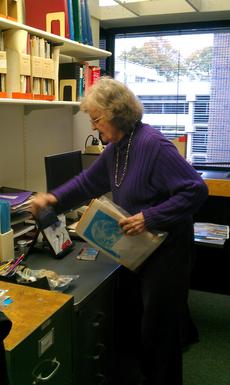 I recently had the opportunity to travel to Cambridge, Massachusetts, to meet with Ursula B. Marvin, a retired geologist at the Smithsonian Astrophysical Observatory who has studied meteorites around the world and lunar samples collected during the Apollo missions.
I recently had the opportunity to travel to Cambridge, Massachusetts, to meet with Ursula B. Marvin, a retired geologist at the Smithsonian Astrophysical Observatory who has studied meteorites around the world and lunar samples collected during the Apollo missions.
Dr. Marvin received a history degree from Tufts College in 1943. In numerous lectures she has spoken about the path that led to her becoming a geologist. Tufts required two years of science courses for liberal arts degrees. Originally not enthused by this idea, Dr. Marvin was surprised by what happened next. She states in a 1997 Adventurous Women Lecture Series, "Geology lit a fire. I fell in love with it the first week." Considered an unacceptable profession for women, when Dr. Marvin approached her geology professor indicating that she wanted to change her major, he said, "You should be learning to cook." Undeterred, she took the "sneaky stratagem" of continuing to pursue history while also taking all the geology classes she could; enough to gain a minor in geology that led to a full-tuition scholarship to study geology at the Harvard-Radcliffe graduate school. At Harvard she became the first woman research assistant in the geology department and received her Master's in 1946.
When her husband Tom, an economic geologist, was approached by Union Carbide to search for mineral deposits in Brazil, Ursula accompanied him and the company paid her expenses. As she describes it, their first years of marriage were a great adventure. They worked in Brazil from 1952 to 1953, Angola from 1953 to 1954, returned briefly to Cambridge, and then returned to Brazil from 1956 to 1958.
With the launch of Sputnik in 1957, the Space Age had begun, and meteoritics opened up as a cutting-edge discipline. Back in Cambridge, Dr. Marvin was presented with the opportunity to study meteorites with Edward L. Fireman of the Smithsonian Astrophysical Observatory (SAO), and was officially hired in 1961. In 1969, the same year Dr. Marvin completed her Ph.D., she became co-investigator with her SAO colleague, John A. Wood, to study lunar samples collected during the Apollo missions. She continued to study lunar samples until 1996.
In 1973, Japanese scientists published a discovery that nine meteorites collected in Antarctica were four completely different kinds of meteorites, not nine pieces of the same meteor shower. The implications were quite significant; this meant that meteorites landing on the ice cap may be frozen in and concentrated together during ice motion, making the Antarctic a rich location for study. Dr. Marvin became the first woman on the American Antarctic research team, traveling three times: during 1978-1979, 1981-1982 and again in 1985.
Dr. Marvin has, from the beginning of her career, been a champion for women in science. She has given numerous lectures at professional meetings and universities, not only about her research, but on her experiences as a woman in a male-dominated profession. She was first in line to submit her $2.00 membership fee in 1946 when women were finally allowed into the Harvard Geology Club, she was the first woman to hold various positions in the geology discipline, and she served as the first Federal Women's Program Coordinator at SAO from 1974-1977.
Among her many accomplishments, Dr. Marvin has published on the Continental Drift, received the Geological Society of America History Award (1986), and has both an asteroid (Asteroid Marvin) and Marvin Nunutak (a mountain peeking through the Antarctic ice) named after her. Dr. Marvin retired in 1998 but continues to publish.
 During my collecting trip to Cambridge, I worked with Dr. Marvin at her office and at her home to identify personal papers for transfer to the Archives. The materials shipped from Massachusetts include highlights of Dr. Marvin's work in the form of correspondence, lectures, professional activity records, reports, and images of her research activities. This new accession also includes documentation of Dr. Marvin's personal life, adding context to her professional papers. Dr. Marvin kept detailed journals, scrapbooks, family photographs, her original art work, and school coursework--all showing another view of her journey. As we looked through her personal papers and discussed her various activities, I learned a great deal about her life and career, and continue to be impressed with her work as I process this new collection.
During my collecting trip to Cambridge, I worked with Dr. Marvin at her office and at her home to identify personal papers for transfer to the Archives. The materials shipped from Massachusetts include highlights of Dr. Marvin's work in the form of correspondence, lectures, professional activity records, reports, and images of her research activities. This new accession also includes documentation of Dr. Marvin's personal life, adding context to her professional papers. Dr. Marvin kept detailed journals, scrapbooks, family photographs, her original art work, and school coursework--all showing another view of her journey. As we looked through her personal papers and discussed her various activities, I learned a great deal about her life and career, and continue to be impressed with her work as I process this new collection.
The finding aid to the Ursula Marvin Papers, Accession 13-060, will be available in the next few months, and will be of particular interest to those studying meteoritics, geology and the history of women in science.
Related Resources
Marvin, Ursula. Continental drift : The Evolution of a Concept, Washington [D.C.] : Smithsonian Institution Press, 1973.
Harvard-Smithsonian Center for Astrophysics - Geologist Emeritas: Dr. Ursula Marvin
Produced by the Smithsonian Institution Archives. For copyright questions, please see the Terms of Use.

Leave a Comment